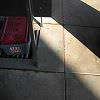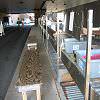Wedge Anchor Removal
Wedge anchors are designed to go into a predrilled hole in concrete and not come out. To remove a wedge anchor from concrete...
An important consideration is that when the wedge anchor is pulled to the ultimate tension value, the concrete fails and both the wedge anchor and a cone of concrete is extracted. There are only two ways to eliminate the wedge anchor from sticking above the concrete, which are:
- Using a cutoff saw or grinding wheel, cut the wedge anchor off at the surface of the concrete.
- Before installing the wedge anchor, drill the hole two times the length of the wedge anchor being installed. This will allow room for the wedge anchor to be pounded into the concrete and be flat with the surface of the concrete. Remember, wedge anchors are designed to go into a hole in the concrete and not come out, so it is possible for the wedge anchor after it is set, to be pounded into the concrete.
concrete Wedge Anchor – Embedment Depth and Tension
| Wedge Anchor Diameter (in) | Embedment Depth (in) | Torque ft/lbs | 2000 psi (Tension) | 3000 psi (Tension) |
|---|---|---|---|---|
| 1/4 | 1-1/8 | 1170 | 1771 | |
| 1/4 | 1-3/4 | 5-10 | 1841 | 2408 |
| 1/4 | 2-3/4 | 1975 | 2748 | |
| 3/8 | 1-1/2 | 1631 | 3636 | |
| 3/8 | 3 | 25-30 | 3229 | 5653 |
| 3/8 | 5 | 4075 | 6328 | |
| 1/2 | 2-1/4 | 3999 | 6714 | |
| 1/2 | 4 | 50-60 | 6336 | 8942 |
| 1/2 | 6 | 6902 | 10175 | |
| 5/8 | 3-3/4 | 4999 | 8747 | |
| 5/8 | 5 | 75-90 | 8854 | 15590 |
| 5/8 | 7 | 9381 | 16710 | |
| 3/4 | 3-1/4 | 6638 | 11314 | |
| 3/4 | 6 | 150-175 | 10084 | 18408 |
| 3/4 | 8 | 11170 | 19805 | |
| 7/8 | 3-7/8 | 8392 | 16354 | |
| 7/8 | 5-3/4 | 200-250 | 12064 | 18250 |
| 7/8 | 8-3/4 | 12784 | 16850 | |
| 1 | 4-1/2 | 9773 | 18250 | |
| 1 | 7-1/2 | 250-300 | 11800 | 26726 |
| 1 | 10 | 15590 | 30491 | |
| 1-1/4 | 5-1/2 | 17550 | 22971 | |
| 1-1/4 | 7 | 400-450 | 21050 | 27845 |
| 1-1/4 | 10 | 27893 | 24788 |
Holding Values
The wedge anchor is an expansion anchor that creates an outward force against the sides of the hole in the concrete. This outward force transfers the energy to the concrete to create the holding values via friction of the wedge anchor in the concrete. The expansion force is in the shape of a “V” when pictured from a side view. If the wedge anchor is pulled to concrete failure then the concrete pullout will be in the shape of a “V” or cone-shaped.
Embedment Depth
The depth of embedment of the wedge anchor into the concrete is one factor that determines the holding values that the wedge anchor will obtain. The deeper that the wedge anchor is embedded into the concrete, then the better the holding values will be.
Minimum Embedment Depth
Each diameter of wedge anchor requires that it is embedded into the concrete a minimum distance in order for the wedge anchor to attain its minimum holding strength. The larger the diameter, then the deeper the minimum embedment into the concrete must be when the wedge anchor is installed.
Torque Values
Each diameter of wedge anchor has a range of torque values that the wedge anchor must be to reach minimum holding values. A torque wrench can be used during the installation process, or it can be used to check the torque value of any wedge anchor once it is installed.
Different Types
Wedge anchors are manufactured from different types of steel, such as standard carbon steel, 303 stainless steel, 304 stainless steel and 316 stainless steel. The holding values and the removal of the wedge anchor are not dependent on the type of steel from which the wedge anchor is manufactured.
Different Manufacturers
Although all wedge anchors work on the same principles, each manufacturer has its own brand names for their wedge anchors. Regardless of whose wedge anchor is being used, the two methods for removal remain the same. The holding values, as stated in the chart above, may vary from one manufacturer to another. The chart refers to the wedge anchor manufactured by concrete Fastening Systems, Inc.
Wedge Anchors
Recent Posts
-
Best Masonry Anchors
Get the job done right the first time by using the best masonry anchors for the application. A mason …Nov 24th 2020 -
Best Cinder Block Fasteners
Fastening to Cinder Block Cinder block …Jun 16th 2020 -
Best Brick Anchors
Male or Female Anchor? Female anchors would require the spotting of the anchor and then place th …Feb 21st 2019



